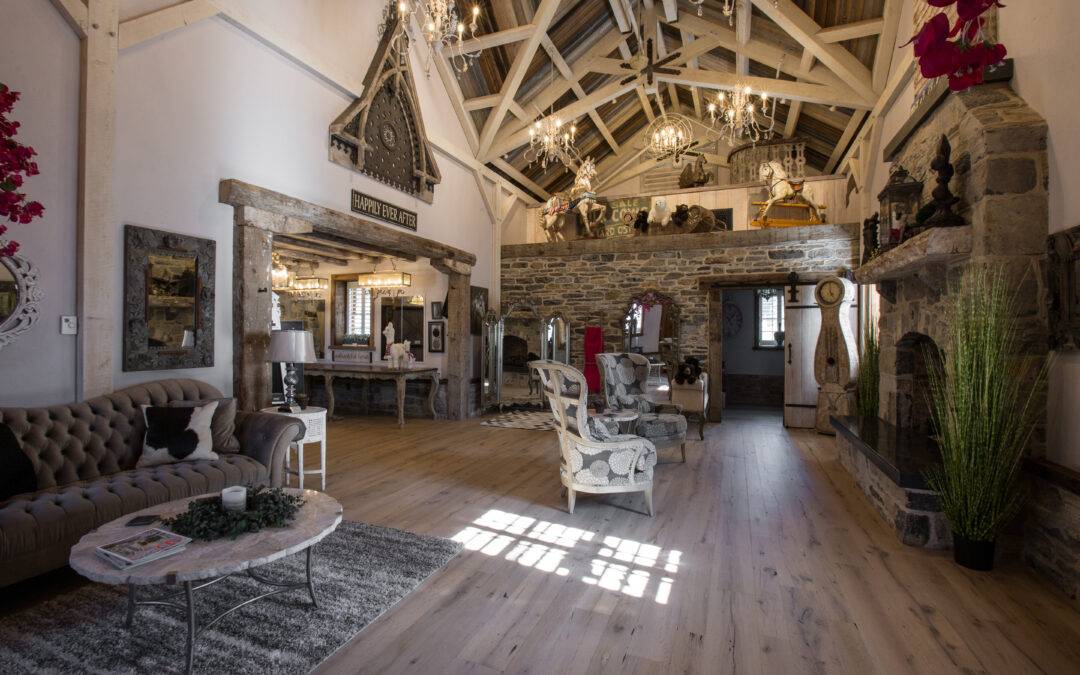Reclaimed Wood Flooring Benefits
At Vintage Wood & Forged Iron, we highly recommend using reclaimed wood for flooring whenever possible. With reclaimed and antique wood:
- You have access to types of wood that cannot be found anymore other than through reclamation (due to overharvesting, extreme weather, or blight).
- You can achieve a luxurious appearance that cannot be compared with new wood, as the coloring of wood becomes richer, deeper, and/or grayed with age.
- Each plank is totally unique. The floor comes with its own history and tells a story the moment you take your first step on it.
To learn all the reasons we love using reclaimed wood for flooring, see our blog post Reclaimed Wood Flooring: What You Should Know. But if you’ve already decided to use reclaimed wood, you may be wondering which wood species works best for flooring. We’ve got you covered there too.
Eight Popular Wood Species Used for Reclaimed Wood Flooring
To know which wood species will work best in your space, it’s important to understand the unique characteristics of some of the more common types of reclaimed wood.
1. Oak
Whether you choose white oak or red oak, oak is a great choice for flooring because it is very dense and resistant to moisture and rot. The fact that oak is used structurally in buildings, too, is a testament to its strength.
While both types of oak have a prominent, interesting grain, white oak’s grain pattern is less busy than red oak’s. White oak is lighter, with a light tan to white color, while red oak is darker, with pinkish to reddish undertones. In aged reclaimed wood, white oak planks turn darker, with beige to brownish or grayish hues, and red oak boards retain their reddish tone but vary from creamy to amber in color.
2. Chestnut
Wood from the American chestnut tree is straight and strong. It is also rot resistant, which made it popular as a building and flooring material for many generations. Unfortunately, the American chestnut was subject to a blight over a century ago and continues to suffer to this day. This means the only way to use American chestnut in your flooring project is to reclaim it from an older structure.
Reclaimed chestnut flooring is some of the nicest on the market. It has a straight grain and comes in varying shades, from rich light brown to darker cocoa.
3. Hemlock
Not to worry! The hemlock used for flooring is not poisonous. Poisonous hemlock is not a tree at all and looks more like a weedy shrub.
A hemlock tree is an evergreen that can grow quite tall. The wood has a lot of texture owing to its uneven, twisted grain, which adds a lot of unique visual interest to a floor. However, although hemlock is one of the hardest of the soft woods, it is still fairly soft, making it one of the least durable reclaimed wood flooring options.
4. Heart Pine
Genuine old-growth heart pine comes from the very core of a pine tree, specifically the slow-growing longleaf pine. At one point in American history, there were approximately 60 million acres of this tree, mostly found in the South. Now, fewer than 10,000 acres remain. Because of the longleaf pine’s previous mass availability, heart pine was one of the most common building materials in North America for a long time, so there are still tons of places to salvage this wood.
Heart pine has a tight grain and is very hard, which makes for very durable wood flooring. It also has a lovely reddish hue, as opposed to the wood from the rest of a longleaf pine, which is a yellowish white.
5. Yellow Pine
It is a misconception that yellow pine is a soft wood. It is surprisingly hardy and dense. Although yellow pine is most commonly for used in decking and dimensional building lumber, it can be equally at home used as interior flooring.
Yellow pine has an interesting grain that is usually interspersed with prominent knots, which brings a rustic elegance to floors. Because of its mass availability in the United States, it is typically easy to find and is a budget-friendly option too.
6. Hickory
Hickory is one of the hardest and most durable reclaimed wood flooring choices available. It is also one of the more water-resistant options and requires minimal maintenance. Hickory is a lighter-color wood. However, its grain varies from straight to swirled, and the colors in the grain vary from light to dark. These variations make for an interesting look overall and gives floors a slightly rustic feel.
7. Maple
Along with oak and hickory, maple is among the hardest wood species in North America. This makes it a popular option for flooring thanks to its durability. In its natural state, maple is light in color with a subtle grain. These attributes give it a more modern, streamlined feel than other species of wood flooring.
8. Walnut
While walnut is more commonly found in cabinetry and furniture, its rich, dark tones make for stunning flooring too. Walnut is not as hard as oak or hickory, so more scratches or dents may result from day-to-day use. However, those dark brown tones help to hide them! Walnut’s grain is relatively straight and uniform, providing an even look to flooring.
Need Help Finding Reclaimed Wood Flooring?
With so many quality reclaimed wood options to choose from, it really all comes down to which of the wood’s features and attributes are most important to you. If hardness and durability are a key factor for your floor, choose a harder wood like maple, oak, or hickory. If a particular color or grain style suits the space best, pick whichever wood species fits those criteria.
No matter which type of reclaimed wood you choose, wood flooring fills any space with warmth and beauty. For more information on how Vintage Wood & Forged Iron can help you choose the right reclaimed wood, contact us today!

